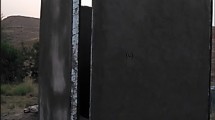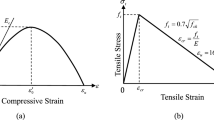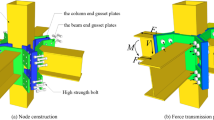Abstract
The material properties of high-strength steels deteriorate under fire conditions and depends on the temperature and fire duration. As a time-dependent inelastic strain behavior, the thermal creep effect becomes significant at elevated temperatures and influences the fire resistance of connections. This paper presents numerical studies on the fire response of unprotected extended end-plate connections made of high-strength steels (Q460, Q690 and Q960), explicitly considering the creep effect. Transient state finite element models including or excluding creep were developed using ABAQUS and validated against the experimental results under the restrained sub-framework. The numerical analysis results exhibit a better agreement with the experimental results regarding the deformation ability and failure mode if the creep effect is considered. Thus, creep is a non-negligible effect in investigating the fire performance of end-plate joints. Parametric studies were carried out to quantitatively assess the influence of moment ratio of connection, axial pressure ratio of column, end-plate thickness and heating rates on rotation–time–temperature characteristics and stress distribution. The numerical results show that the magnitudes of bending moment applied on the connection and axial load on the column play crucial roles in evaluating the fire endurance and critical temperatures. However, the effect of end-plate thickness on the fire-structural behavior of extended end-plate connections is negligible. The heating rate has little effect on the critical temperatures of connections. The rotation capacity of high-strength steel extended end-plate connections depends on the failure mode to a large extent. Finally, fire resistance design suggestions for high-strength steel end-plate connections were put forward according to the observations on the parametric studies.





















Similar content being viewed by others
References
Ramli-Sulong NH, Elghazouli AY, Izzuddin BA (2007) Behavior and design of beam-to-column connections under fire conditions. Fire Saf J 42(6–7):437–451
Li YD, Zhao JC (2020) Research review on the behavior of steel beam to column end-plate connections in fire. Prog Steel Build Struct 22(1):1–7 (in Chinese)
Haddad HO, Hantouche EG, Karimhatib KA (2019) Numerical studies on the creep behavior of shear endplate connection assemblies under transient heating. Fire Technol 55:2341–2367
CEN (2007) Eurocode3: design of steel structures, part 1–12: additional rules for the extension of EN 1993 up to steel grades S700, S. Brussels
Luo YF, Ren CC, Qiang XH (2016) State-of-the-art on fire-resistance behavior of high strength steel structures. J Tianjin Univ (Sci Technol) 49(S1):104–121 (in Chinese)
Wang WY, Li GQ, Dong YL (2007) Experimental study and spring-component modelling of extended end-plate joints in fire. J Constr Steel Res 63:1127–1137
Wang WY, Dong YL, Li GQ (2006) Experimental and analytical studies on extended end-plate connection in fire. J Harbin Inst Technol 38(12):2125–2128 (in Chinese)
Wu ND, Luo YF, Qiang XH (2018) Experimental and numerical analysis on high strength steel extended end-plate connections in fire. J Southeast Univ 48(1):138–145
Qian ZH, Tan KH, Burgess IW (2009) Numerical and analytical investigation of steel beam-to-column joints at elevated temperatures. J Constr Steel Res 65(5):1043–1054
Wang YC, Dai XH, Bailey CG (2011) An experimental study of relative structural fire behavior and robustness of different types of steel joint in restrained steel frames. J Constr Steel Res 67(7):1149–1163
Yang JJ, Wang WY (2021) The influence of high temperature creep on the fire resistance of cold-formed steel columns. Prog Steel Build Struct 7:67–75 (in Chinese)
Kodur V, Dwaikat M, Fike R (2010) High-temperature properties of steel for fire resistance modeling of structures. Mater Civ Eng 22(5):423–434
Hantouche EG, Al Khatib KK, Morovat MA (2018) Modeling creep of steel under transient temperature conditions of fire. J Fire Saf 100:67–75
Fields BA, Fields RJ (1989) Elevated temperature deformation of structural steel, 1988. National Institute of Standards and Technology, NISTIR, NIST: 88-3899
Wang WY, Yan SH, Liu JP (2017) Studies on temperature induced creep in high strength Q460 steel. Mater Struct 50:68
Wang WY, Wang K, Kodur V (2018) Mechanical properties of high-strength Q690 steel at elevated temperature. J Mater Civ Eng 30(5):04018062
Li X, Wang WY, Zhang YH (2021) Creep of domestic high strength Q960 steel at elevated temperature and its effect on fire resistance of steel columns. Chin Civ Eng J 54(6):26–34 (in Chinese)
Harmathy TZ, Stanzak WW (1970) Elevated-temperature tensile and creep properties of some structural and prestressing steels. Fire Test Perform 464:186–208
Hua YJ (2000) Study on fire response and fire-resistance of pre-stressed concrete structures, D. Tongji University, Shanghai (in Chinese)
Zhou HT, Nie HB, Li GQ et al (2014) Experimental research on creep properties of pre-stressed steel strand in 1860 MPa at high temperature. J Build Struct 35(6):123–129 (in Chinese)
Morovat MA, Engelhardt MD, Helwig TA (2014) High-temperature creep buckling phenomenon of steel columns subjected to fire. J Struct Fire Eng 5(3):189–202
Harmathy TZ (1976) Creep deflection of metal beams in transient heating processes with particular reference to fire. Can J Civ Eng 3(2):219–228
Wang WY, Liu B, Kodur V (2013) Effect of temperature on strength and elastic modulus of high-strength steel. J Mater Civ Eng 25(2):174–182
Wang WY, Zhang YH, Xu L (2020) Mechanical properties of high-strength Q960 steel at elevated temperature. Fire Saf J 114:103010
Pang XP, Hua Y, Tang SL (2019) Physical properties of high-strength bolt materials at elevated temperatures. Results Phys 13:102156
Cao YZ, Liu XL, Lu Y (2022) Research progress in the mechanical properties of steel frames with different connection forms. Prog Steel Build Struct 24(2):1–21 (in Chinese)
International Organization for Standardization (1975). ire resistance tests-elements of building construction: ISO 834, S. International Organization for Standardization
SIMULIA—Dassault Systèmes (2013) Abaqus analysis User's Guide, Vol 2 (6.2.5)
Coelho AMG, Bijlaard FSK, Silva LSD (2002) On the deformation capacity of beam-to-column bolted connections, C. European Convention for Constructional Steelwork-Technical Committee 10: Structural connections. Coimbra, [s.n.], pp 1–8
Coelho AMG (2004) Characterization of the ductility of bolted end plate beam-to-column steel connections. University of Coimbra, D. Coimbra
Qiang XH, Frans SK, Bijlaard FSK et al (2014) Behaviour of beam-to-column high strength steel end-plate connections under fire conditions—part 2: numerical study. Eng Struct 64:39–51
European Committee for Standardization (2005) Design of Steel Structures, Part 1.8: Design of Joints: EN 1993-1-8 Eurocode 3. European Committee for Standardization, S. Brussels
Qiang XH, Bijlaard FSK, Kolstein MH et al (2014) Behaviour of beam-to-column high strength steel end-plate connections under fire conditions-Part 1: experimental study. Eng Struct 64:23–38
Kodur V, Dwaikat M (2010) Effect of high temperature creep on the fire response of restrained steel beams. Mater Struct 43(10):1327–1341
FAILNOMORE (2021) D3-1: design recommendations against progressive collapse in steel and steel-concrete buildings. S. European Convention for Constructional Steelwork
Acknowledgements
The authors wish to acknowledge the Natural Science Foundation for Distinguished Young Scholars of Chongqing (Grant No.: cstc2021jcyj-jqX0021) and Natural Science Foundation of China (Grant No. 52178110) for supporting this research. Any opinions, findings, and conclusions, or recommendations expressed in this paper are those of the authors and do not necessarily reflect the views of the sponsors.
Author information
Authors and Affiliations
Corresponding author
Ethics declarations
Conflict of interest
We declare that we do not have any commercial or associative interest that represents a conflict of interest in connection with the work submitted.
Additional information
Publisher’s Note
Springer Nature remains neutral with regard to jurisdictional claims in published maps and institutional affiliations.
Rights and permissions
Springer Nature or its licensor (e.g. a society or other partner) holds exclusive rights to this article under a publishing agreement with the author(s) or other rightsholder(s); author self-archiving of the accepted manuscript version of this article is solely governed by the terms of such publishing agreement and applicable law.
About this article
Cite this article
Wang, W., Chen, Z. & Zhang, L. Numerical Studies and Practical Design Suggestions on Fire Resistance of Unprotected High-Strength Steel Extended End-Plate Connections. Fire Technol 59, 1585–1612 (2023). https://doi.org/10.1007/s10694-023-01397-5
Received:
Accepted:
Published:
Issue Date:
DOI: https://doi.org/10.1007/s10694-023-01397-5




